Archive
Workout Weight Gain
Q. I started exercising and have gained five pounds! My BMI is still within the healthy limits (barely). But I’d like to lose—not add—more weight! Why is exercise making me heavier instead of lighter? What am I doing wrong?
A. Not all exercise is the same. So without knowing what type of exercise you’re doing, how much and how often—and for how long you’ve been doing it—it’s hard to speculate as to why you might be gaining weight.
Are you going to yoga class seven days a week? Are you doing 50 crunches every morning (and nothing else)? Are you walking on the treadmill for 20 minutes, but only twice a week? While each of these approaches may improve your fitness level, they don’t add up to a large enough calorie burn to significantly affect your body weight. The type of exercise and how much of it you do makes all the difference when it comes to shedding pounds.
LOW CALORIE BURNERS vs. HIGH CALORIE BURNERS
Generally, the fitness recipe for weight loss is to increase the amount of cardio you do in order to burn a significant amount of calories per session. Theoretically (assuming you don’t eat more than usual), if you burn 3,500 calories, you will lose one pound of fat.
Muscle-conditioning activities tend not to burn many calories. You do burn extra calories from these workouts—it just might not be enough to see a difference in a short amount of time.
Consider this: You burn about one calorie per minute sitting. Exercises where you stretch or target specific muscles such as when doing ab work or pushups, for example, burn around two or four calories a minute. But walking, running or dancing can burn from five to 10-plus calories per minute.
Don’t be fooled into thinking that you’re burning lots of calories because you feel a burn and you’re breaking a sweat. You might be huffing and puffing because the room is hot and not because you are metabolizing lots of energy.
Moves that generate specific muscle fatigue (your arms quiver, your abs burn, your legs shake) may feel tough, but they still may not burn that many calories overall. For example, walking briskly—where you don’t feel a burn, but your heart rate increases because many muscles work in unison over an extended period of time—uses up more energy than 100 crunches. That’s why you’ll decrease more fat in your belly from walking than from doing ab work, which may feel more difficult.
So, yoga, Pilates, lifting weights and other types of body conditioning workouts tend not to be calorific enough to make a big dent in fat stores. A 30-minute stretch and ab workout might burn around 60 calories, while a 30-minute walk might burn 150 calories, and a (higher intensity) 30-minute step class might burn about 250 calories.
HOW LONG TO LOSE 10 POUNDS?
In theory, to lose 10 pounds of fat (or burn 35,000 calories) by working out four days a week for 30 minutes, it would take:
- About 145 weeks (or almost 3 years) from yoga and ab workouts;
- Some 58 weeks (about a little more than one year) from short, moderate-intensity walks;
- Or 35 weeks (about eight months) from higher-intensity cardio such as a step workout.
Of course, eating slightly less while adding in the extra calorie burn from any of these workouts—or lengthening each exercise session—can speed up the weight loss.
While there is not yet a specific recommendation for exactly how much exercise results in weight loss, general recommendations are to include from 30 to 90 minutes of moderate to high intensity activity into your day, on most days of the week.
GAINING AT THE SAME TIME YOU START EXERCISING
Cutting calories from what you eat each day is easier than burning up extra calories through exercise: You can easily shave 500 to 1,000 calories off a day’s meals but cutting out soda, fried foods and sweets that you might normally eat. But burning this many calories from working out takes a lot more work—about one to two hours of exercise per day, depending on the type and intensity. That’s why people seem to feel that diets work better than exercise when it comes to weight loss—they work faster.
You’re not the first to feel like you are gaining weight from working out. Assuming that you are doing longer, calorie-intensive workouts more frequently, there may be other explanations:
Some people eat more when they start to exercise. There doesn’t seem to be evidence that your body actually gets hungrier, especially with lower intensity or shorter workouts. But there may be a psychological disinhibition: “Hey, I worked out, I can have that extra serving, or maybe even dessert.” Also, some research suggests that women may become less active when they add exercise to their day. This, too, may be some sort of psychological compensation: “I worked out, I can sit on my butt for the rest of the day.”
Sometimes, as people get fitter, their bodies become more efficient, especially at utilizing carbs better. So you develop the ability to store more glycogen, or carbs, in your muscles. Those molecules contain added water, which means that you MIGHT increase your water weight as you get fitter. This isn’t likely to make a huge difference on the scale, though.
Some people assume that they gain muscle and this makes them heavier, too. Unless you are lifting heavy weights and eating more, it’s unlikely that you’re gaining muscle weight. Even then, it might take six months to gain a couple of pounds.
Keep in mind, too, that body weight fluctuates by as much as three to five pounds daily. And you might even be shaping up more than you realize if your clothes are getting loser, despite what the scale says. (You can decrease body fat—helping your look slimmer—without losing much weight.)
Do you have a fitness or weight-loss question for Martica? Send e-mail to experts@microsoft.com. Please include Ask Martica in the subject line. Each of our experts responds to one question each week and the responses are posted on Mondays on MSN Health. We regret that we cannot provide a personalized response to every submission.
Martica is a Manhattan-based exercise physiologist and nutritionist and an award-winning fitness instructor. She has written for a variety of publications including Self , Health , Prevention , The New York Times and others. Martica is the author of seven books, including her latest, – Cross-Training for Dummies . (Read her full bio.)
When a Man’s Sex Drive Is Too Low
The male libido is always in overdrive, right? Wrong — one out of five men actually have a low sex drive.
Men. High sex drive. Panting sexual animals. We know what they want. And we know when they want it: right now.
Even doctors tend to see men as “sexual automatons,” hardwired always to want sex, says pioneering sex researcher Irwin Goldstein, MD, director of sexual medicine at San Diego’s Alvarado Hospital and editor in chief of The Journal of Sexual Medicine. “But that is not the case at all,” Goldstein tells WebMD Magazine. “Many, many men — about one in five –have such low sexual desire they’d rather do almost anything else than have sex.”
One in five men doesn’t want sex? How can that be true? And why haven’t we heard about it? Actually, many women have — the ones hearing the phrase “Not tonight, dear.” Goldstein says most people think that is a rare occurrence. “But in fact, almost 30% of women say they have more interest in sex than their partner has.”
The causes of low sex drive
So what’s behind low sexual desire? Aging plays a role, though many older men have a robust interest in sex, Goldstein points out. Like most other human traits, the sex drive varies. Most men are in the normal range; some are extraordinarily driven toward addiction-like sexual behavior. At the other end of the scale are men with very low sexual interest. These are men who suffer from hypoactive sexual desire disorder (HSDD).
“There are always men on both sides of the normal curve,” Goldstein says. “And a certain percentage — perhaps up to a quarter — will be considered to have HSDD for a whole host of reasons.” These include:
Psychological issues. Stress and anxiety from the strain of daily life, relationship or family problems, depression, and mental disorders are among the many factors that can affect sexual desire.
Medical problems. Diseases such as diabetes; conditions such as obesity, high blood pressure, and high cholesterol; and HIV drugs, some hair-loss remedies, and other medications can negatively affect sexual desire.
Hormonal causes. “Testosterone is the hormone of desire, arguably for women as well as for men,” Goldstein says. Low testosterone levels usually mean low sexual desire. Levels dip as men age; other causes include chronic disease, medications, and other drug use. Other hormones can play a role, too, such as low levels of thyroid hormone or, rarely, high levels of prolactin, a hormone produced in a gland at the base of the brain.
Low dopamine levels. Sexual desire obviously involves the brain — and the brain’s chemical messaging system is intimately linked to sexual desire. One of those messengers is dopamine. Doctors have noted that Parkinson’s disease patients treated with dopamine-stimulating drugs had increased sexual desire. Goldstein says these drugs help some men with HSDD.
Each cause of low sexual desire has its own treatment. When the root cause is psychological, sex therapy can offer men specific techniques and strategies for regaining their enjoyment of sex. “It is not psychotherapy; it is psychology counseling focused on sexual issues,” Goldstein explains.
In cases where the problem is low testosterone, men can take testosterone supplements if they have measurably low levels. About 25% of men go for weekly testosterone shots, Goldstein says, but most opt for skin patches or gel formulations applied directly to the skin of the chest, shoulders, or abdomen.
When Goldstein suspects low dopamine levels are at the heart of a man’s low sexual desire, he might prescribe dopamine-increasing drugs, though this treatment is not currently approved by the FDA and has risks.
However, a new drug now in clinical trials — for women — does increase dopamine levels while decreasing a specific kind of serotonin in the brain. Early clinical studies suggest the drug could help women with low sexual desire. Goldstein thinks this new treatment has promise. And if it’s approved for women, he says, it will likely be tested in men.
In the end, the choice for men who’ve lost their desire for sex is not between being a panting sexual animal and being a eunuch. Instead, the real choice is whether these men are ready to regain a vital source of intimacy with their partners — and a key part of a healthy life for themselves.
Michael Jackson Dies of Reported Cardiac Arrest
Paramedics Reportedly Performed CPR Before Rushing Jackson to Hospital
Pop star Michael Jackson has died at age 50 after suffering a cardiac arrest, according to media reports.
Los Angeles TV station KTLA reports that Los Angeles fire officials said they responded to a 911 call at Jackson’s home and that Jackson wasn’t breathing when they arrived; paramedics performed CPR and rushed him to UCLA Medical Center, although the hospital, due to privacy rules, could not confirm that.
[Editor’s Update: Although not denying that Jackson died of cardiac arrest, Los Angeles County Coroner spokesman Craig Harvey, after the initial autopsy on Friday, says the cause of death will be deferred until further toxicology tests can be conducted. He anticipates final results in four to six weeks.]
In a cardiac arrest, the heart stops working properly. A cardiac arrest is not the same as a heart attack, but it can happen because of a heart attack, notes Douglas Zipes, MD, MACC, distinguished professor at Indiana University School of Medicine and past president of the American College of Cardiology.
Zipes explains that “cardiac arrest is a heart rhythm disturbance when the bottom chamber of the heart, the ventricles, beat an at extremely rapid rate — 4 to 600 times a minute.”
Zipes says that heart rhythm “prevents that bottom chamber from effective contraction and pumping blood to the brain and to the rest of the body, and death results if it’s not reversed within four or five minutes, generally.”
According to Zipes, when that heart rhythm disturbance, which is called ventricular fibrillation, happens, the bottom chambers of the heart are “like a bag of squiggly worms without an effective squeeze, and no blood gets pumped to the rest of the body, and without the necessary oxygen in the blood vessels going to the brain, and so on, the brain then begins to die.”
CPR can help keep blood flowing, but it would take an electrical shock to the heart — either from electrical paddles called defibrillators or from an internal heart device — to shock the heart back to a normal rhythm.
“Some sort of blood flow has to be initiated, whether it’s with CPR or with the shock that terminates the fibrillation and restores an effective contraction,” says Zipes.
Zipes notes that in 30% to 50% of cardiac arrests, “that event is the first manifestation of underlying heart disease. So you may not have chest pain, you may not have shortness of breath, you may not have anything” as a warning sign.
Just over a year ago, NBC journalist Tim Russert died after a cardiac arrest. Russert was being treated for his heart disease risk factors; Jackson’s previous heart health hasn’t been made public.
Weird Architecture – Strange & Unique Buildings in the USA
Architecture is an important part of travel. It is the postcard out your window that lets you know you are here. You’ve arrived. You know you are in Russia when surrounded by onion domes, New York when you can only see skyscrapers and Seattle when you can’t see anything because there is rain in your eyes. That’s the role of architecture, and to a lesser extent, weather. Here is a group of ten fantastic, incredible and weirdly, wonderful buildings in the U.S. that are worthy of a visit if you are on vacation or just happen to be in the neighborhood. More than one of them make me think of Star Wars.

Longaberager corporate Headquarters is a picnic basket.
1. Let’s start with my favorite which is found in Newark, Ohio, the picnic basket aka Longaberger corporate headquarters. This fanciful creation was the dream of the Longaberger Basket company’s founder Dave Longaberger. It is said, most people (employees, bankers, architects and builders) didn’t take him seriously at the time. I wonder why.

Kansas City Public Library
2. This was designed by Dimensional Innovations and it camouflages the parking garage. The fantastic book titles were suggested by Kansas City residents. See the building and read the classics! Photo courtesy of: ChicagoEye.

Robert Bruno
3. This award winning home in Lubbock, Texas took 28 years to complete and is designed by Robert Bruno. It doesn’t really say “come in and take your shoes off,” though, does it? But it is engaging and I do want a peek inside.
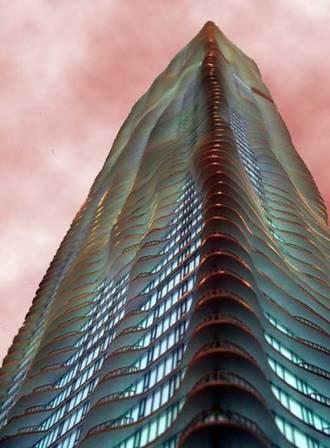
Aqua Building, Chicago, Illinois
4. The Aqua Building was on a list from Syed Mobin Architects. It is scheduled to be finished in 2009 and is in Chicago, Illinois. Design is from Studio Gang Architects.
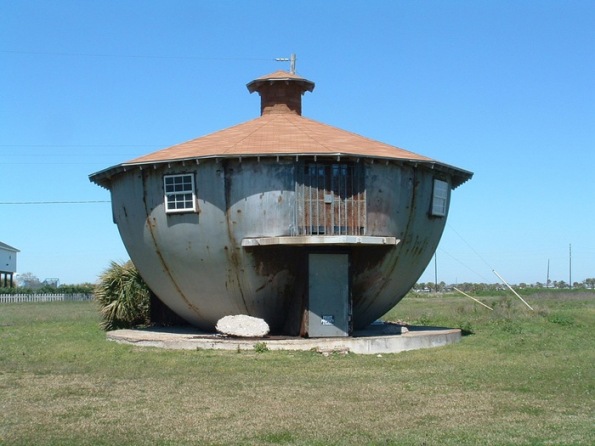
Kettle House, Texas
5. Kettle House, in Galveston, Texas – I wonder, when the wind comes sweeping ‘cross the plains, does it whistle?

Shoe House, Hallam, Pennsylvania
6. Shoe House in Hallam, Pennsylvania was not built by an old woman but was built by a shoe millionaire and it is a real house. No word on the number of children, if any, that reside in it.

Air Force Academy Chapel
7. This chapel falls into the wonderful category. Its stark beauty could soothe a soldier’s soul. It is located in the US Air Force Academy in Colorado.

Oakley Headquarters
8. This awesome futuristic building is the corporate headquarters for Oakley. What do you think? I love the description, “Oakley’s design bunker is where inventions are conceived, developed, perfected and manufactured. In addition to the hidden catacombs of research labs and proving grounds, the architectural design of Oakley President Colin Baden includes an NBA basketball court, a 400-seat amphitheater, and absolutely no adult supervision.” I wonder if they’re hiring.
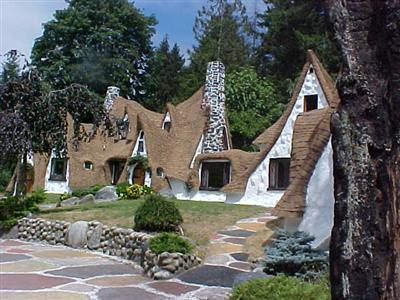
Story Book House in Ollala, Washington
9. Built in Ollala, Washington, this looks like it belongs in a Grimm’s fairy tale (or Disneyland) . Photo courtesy of Unusuallife.com
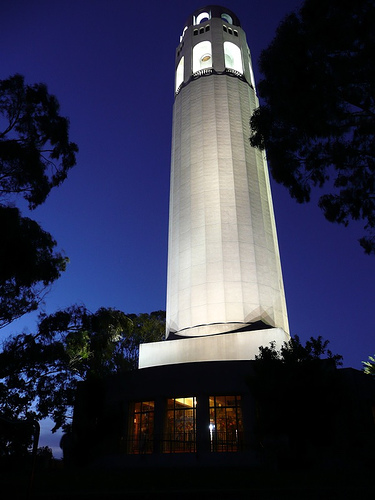
Coit Tower, San Francisco
10. My final choice from all the weirdness of American architecture is Coit Tower in the beautiful city of San Francisco. They say this San Francisco icon isn’t a fire hose nozzle, but those of us who know the story think otherwise. The story is told a need-to-know basis. Beautiful photo courtesy of http2007.
So what did you think? Pretty cool, right? If you have any weirdly, wonderful buildings that you think we should add to our travel itineraries, let us know. Just leave a suggestion in the comments.
The Ten Best Bare Beaches in the World
Below are 10 of the best beaches for baring all. All details are taken from Bare Beaches, which lists over 200 other popular spots for nude bathing around the world.
1. Leucate Plage, France
Mediterranean coast, north of Perpignan
This superb bare beach has 1 km of fine golden sand, the classic Mediterranean beach. The water is normally calm and the shore shelves gently into the sea making it popular with families. Three naturist resorts share the coastline but the beach is open to all and there’s plenty of space for first-time skinny-dippers and lifelong nudists alike. Go north from Perpignan on the main N9 and turn right on to the D83, signposted Port Bacares. After 9 kms turn left on to the D627, drive through Port Leucate and the bare beach is on the right. Park on the road – easy public access between Aphrodite Village and Club Oasis, the naturist resorts.
2. Playa Es Pregons Gran, Balearic islands
Majorca south coast
This wonderful little bare bay has a perfect crescent of fine yellow sand, washed by a sea so transparent it looks more like the Caribbean. There are no beach bars so bring your picnic and drinks. It’s the jewel in the crown of the popular Es Trenc beach area.
The route to the beach is a pleasant 15 minute walk along the shore, heading north from the resort town of Colonia Sant Jordi. Start at the Hotel Marques Del Palmer, and it’s the third bay along. The fourth bay, if you walk further, also happens to be a bare beach, part of the much larger Es Trenc beach.
3. Haulover Beach, Florida USA
Sunny Isles, north Miami
Situated in the south of the ‘Sunshine State’, this bare sandy beach has a huge following of visitors from across the globe. With glorious weather for most of the year and the vibrant city of Miami on the doorstep, it’s not difficult to see why. The bare area is more than 800 yards long and has its own lifeguards and unobtrusive police patrols. Refreshments, sunbeds and umbrellas are available.
The beach is at Haulover Beach Miami-Dade county regional park, on Collins Avenue (A1A), just north of fashionable Bal Harbour. There is a large car park ($5) right by the beach.
5. Banana Beach, Greece
Skiathos, near Koukounaries, on the south-west coast
Banana beach is the collective name for three lovely sandy bays well loved by nude bathers. Before you ask, the name refers to the fact the beaches are yellow and curved. View photos of sunbathers at this beach here.
During peak season bare bathers mainly use Little Banana, one of the smaller coves, as clothed holidaymakers descend on the main beach. Little Banana is often called the best bare beach in Greece, although there is plenty of competition for the accolade. There is a bus terminus and car park at the end of the Koukounaries road, coming from Skiathos town. The footpath to Banana takes 15 mins through olive groves.
6. Valalta, Croatia
Istria, near Rovinj
If you feel the need for a truly naked de-stress, Valalta is everything you could wish for. It’s so good the nudist campsite here was voted the best in Croatia last year – among all sites, not just bare ones. With two miles of sand and rock beaches, including secluded coves, lined by olive trees and vineyards, this nude beach and village are well loved by bare beach connoisseurs.
The beach is on the Istrian peninsula, 60 miles south of Trieste and five miles from Rovinj. You can visit for the day (€2 entry) or book holidays through UK nude beach specialist Peng Travel (0845 345 8345) or http://www.valalta.hr
7. Playa de Maspalomas, Canary Islands
Near Playa del Ingles, southern Gran Canaria
Hundreds of acres of sand dunes, looking just like the Sahara, frame the beautiful beach between Maspalomas and the popular resort of Playa del Ingles. It’s 3 kms from one end to the other and over 1 km deep. The bare areas, like the swimsuited ones, have sunbeds and umbrellas for hire. For a quieter spot, walk into the vast expanse of dunes, but be careful not to get lost!
You can walk to the bare beach areas from either end, although the walk from Maspalomas town is slightly shorter.
8. Euronat, France
Atlantic coast, north-west of Bordeaux
The south-west coast of France is almost one vast nude beach, stretching over 100 miles from Biarritz to the Gironde. Among stiff competition, the nude resort beach of Euronat stands out for its clean golden sand, supervised swimming and friendly atmosphere. Thousands of happy families gather here, and the beach is open to both nudist campers and day visitors alike. Other highly regarded resort beaches heading south are Montalivet CHM, La Jenny and Arnaoutchot.
From the seaside town of Montalivet-les-Bains, drive north on the D102 coast road. After 3 kms the road turns sharply right inland. Park and walk on to the beach – the main bare area is to the right.
9. Plakias Beach, Greece
Plakias town, south-west Crete
A fabulous setting of cliffs, mountains and a huge sweep of golden sand make this beach a wonderful place for all-over tanning and fine snorkelling. The sea shelves gently, making it suitable for families, and there are showers available. Refreshments are brought to the beach in season, and umbrellas are available.
The nude area is the last section of the beach, to the left as you face the sea, and unsurprisingly it is often the most popular part of the whole bay.
10. Les Grottes Plage, France
Ile du Levant, Mediterranean
This gem of a beach on the magical island of Levant is reached by an easy coastal footpath 10 mins walk from the quayside. A small natural cove of white sand slides gently into the turquoise sea, providing excellent swimming and snorkelling. The easiest way to get here is by ferry from Le Lavandou, between St Tropez and Toulon.
Seventy years ago Ile du Levant was the birthplace of nude leisure in France. Today, there is a tiny resident community and lots of holiday accommodation. Minimal clothing is normally worn in the village of Heliopolis, but the rest can be enjoyed as nature intended.
20 best deserted beaches
It is travel’s Holy Grail – powder-white sand, a turquoise blue sea and not another soul in sight. But unspoilt, secret beaches do still exist, and, as Gemma Bowes reveals, you don’t always have to go to the ends of the earth to find one…
Europe
1 Luskentyre
West coast of Harris, Scotland
Resembling a South Pacific tropical island, the west coast of Harris is edged with wide beaches of silvery and golden sand that are possibly the finest in the UK. But the island’s far-flung location means few mainlanders haul their buckets and spades up there. Drive between Luskentyre and Traigh Scarasta and you’ll spot dozens of gorgeous empty beaches, including the long, narrow Luskentyre.
McKinlay Kidd’s (08707 606 027; www.seescotlanddifferently.co.uk Hebridean Hopscotch tour takes in the isles of Harris, Syke, Barra and Uist, and includes six nights’ B&B, plus ferry crossing for a car from Oban, returning to Ullapool, from £480 per person.
2 Vallee De L’ortolo
Corsica
Deep in the sparsely populated Vallee de l’Ortolo in the southern region of Sartène, lie hidden beaches and secret walking trails, few of them known to those not staying at the U Cavaddu Senza Nome (00 33 495 771 847) campsite and riding centre. Once a major wine-growing region until phylloxera lice put paid to all but a couple of the vineyards, the valley feels wild and abandoned and the beaches make fine solitary retreats and a quiet alternative to the famous Roccapina beach to the east. The valley is three miles south of Sartène, off the N196. Return flights to Figari from Gatwick and Manchester are available from www.thomsonfly.com from £89.
3 Castrocucco
Basilicata, Italy
The Basilicata region is one of Italy’s best-kept secrets. Among the country’s poorest regions, it is rugged and unspoilt. Dozens of gorgeous secret beaches await walkers who conquer the twisty coastal paths, one of the prettiest being Castrocucco, a 15-minute drive south of Maratea, a bustling fishing port. As well as sweeping coastal views south towards Calabria, it has a ruined castle and dramatic blowholes in the rocks along the shore. Headwater (01606 720 199; www.headwater.com) runs walking holidays to the region, including hotel accommodation and flights to Naples from £879pp.
4 Ransvik
Sweden
This hidden beach in the Kullaberg nature reserve in the Skane area of southern Sweden has great cliffs from which to fling yourself into the North Sea. It also has a somewhat sordid history: it is said to be where Swedish sin was born when it became a unisex beach at the beginning of the 20th century and, unusually, allowed men and women to swim together. Richard Gere, seduced by the atmosphere of seclusion and privacy was caught out by the paparazzi swimming naked with a mystery Swedish woman there.
A selection of cottages in Skane are available from www.bookcottages.com, including two-bedroom places from £170 a week. Flights to Malmo from Stansted cost from around £35 return with Ryanair (www.ryanair.com).
5 Fakistra
Pelion, Greece
Fakistra is a sandy beach with rocky outcrops at each side creating a turquoise lagoon, with a waterfall and cool pool behind it. It’s a gorgeous hidden spot in a quiet part of the Pelion Peninsula, north of Athens, and a 90-minute walk down a cobbled path from the tiny, car-free hamlet of Damouchari, which passes an ancient school where Greek language and culture were taught in secret during the oppressive Ottoman regime, and winds through overgrown olive groves. Stay in the peaceful and bohemian Damouchari Hotel, which also looks out on to its own white pebble beach, with Sunvil (020 8568 4499; www.sunvil.co.uk), from £487pp per week with flights and B&B.
The Americas & The Caribbean
6 Casperson Beach
Sarasota, Florida
Windswept, untouched and covered in shells – and a few pre-historic sharks’ teeth – Casperson Beach on the Gulf Island of Sarasota, off Florida’s west coast feels like it’s a million miles away from the region’s theme-parks and shopping malls. A nature trail leads from the beach to freshwater and saltwater marshes, mangrove swamps and tidal flats. Sarasota has plenty of theatres, museums and nature parks too. Details from Sarasota and Florida’s Gulf Island tourism (020 7681 6275; www.sarasotaandfloridasgulfislands.co.uk). Flights to Tampa with United Airlines from Heathrow cost from £440 at Flight Centre (0870 499 0040). Seven nights at the Inn at the Beach (00 1 800 255 8471; www.innatthebeach.com) cost from £484 for a double.
7 Cooper Jack Beaches
Providenciales, Turks & Caicos Islands
Providenciales is just one of the 49 islands that make up Turks and Caicos. Although it’s not uninhabited, there are some secluded spots as most visitors don’t stray from the stunning, busier beaches – such as 12-mile long Grace Bay – which have baby-powder sand and turquoise water.
Stay at the Harbour Club Villas (00 1649 941 5748; www.harbourclubvillas.com) on the peaceful south side of the island, hire a kayak, and your hosts Barry and Marta will tell you where to find the deserted coves of the Cooper Jack beaches. There are six one-bedroom villas in the complex, and the beaches seldom attract those who aren’t staying there. A villa for two costs from £98 a night. Flights to Providenciales from around £700 return with British Airways (0870 850 9850; www.ba.com).
8 Kaupoa Beach
Molokai Island, Hawaii
About 2,400 miles from the nearest continent, the Hawaiian Islands are the most isolated on the globe, the sensation of which can be heightened by visiting their hidden beaches. Once a closely guarded local secret, Kaupoa Beach on Molokai, one of Hawaii’s least visited islands – has had a small increase in visitors since Molokai Ranch (00 1 808 552 2824; www.molokairanch.com) opened its ‘tentalows’, or luxury tent cabins, there, but it is still deathly quiet. Kaupoa beach has toothpaste-white coves and the surrounding landscape resembles an African savannah with its red soil. Nearby Kahalepohaku and Kapukuwahine beaches on the southwest shore are also deserted, though the sea can be too dangerous for swimming when it’s rough and there are strong currents, especially in winter. Tentalows for two cost from £200 a night. Flights to Hawaii and on to Molokai cost around £750 with Continental Airlines (00 1 800 231 0856; www.continentalairlines.com).
9 Playon de Mismaloya
Mexico
The only way to the private Playón de Mismaloya beach, 60 miles south of Puerto Vallarta, is on the rowing boat used to cross the estuary from Hotelito Desconocido. The pristine beach extends for 40 miles in front of the hotel’s stilt houses, and it is one of the country’s, and indeed the world’s, most important sanctuaries for turtles, which hatch between June and January. Visitors can spot birds nesting in the wetland lagoon’s wild vegetation all year round. There is no electricity, so at sundown candles are lit throughout the hotel.
Doubles from £166 a night from travel intelligence.net. Flights to Puerto Vallarta cost around £700 with First Choice (0870 850 3999; www.firstchoice.co.uk).
10 Chacocente Wildlife Refuge
Nicaragua
Apart from the occasional gap-year student tagging turtles for a conservation project, you are unlikely to see anyone else on this protected spot of beach on the Pacific coast to the east of Managua, which is only accessible by horse or in a four-wheel drive. The beach is a small part of the wildlife reserve, which is dominated by the largest tract of unspoilt dry tropical forest ecosystem in Nicaragua and runs along the Río Escalante. Rare Paslama turtles lay their eggs here between July and January. There is a campsite there, but little else, see www.jinotepenicaragua.com and www.intur.gob.ni.
Flights to Managua cost around £650 with Iberia Airlines (0870 609 0500; www.iberia.com).
11 Rio Frutilla
Bahia Arenal, Chile
The remote beaches and fjords of the Pacific coast of southern Chile are in one of the world’s great wildernesses. Dolphins, penguins and sea lions are year-round residents in Bahía Arenal, and may be your sole companions. Travel there is tricky, and involves a flight to Santiago, one to Puerto Montt, a light aircraft to Chaitén, a drive to the mouth of the Río Palena, and a boat to Bahía Arenal. Once there you will find hospitality and good grub at the Bahía Arenal lodge, and can spend time sea kayaking, fishing and lazing on the beach.
Cazenove and Loyd (020 7384 2332; www.cazloyd.com) offers a week all- inclusive at the lodge, including all transport from £3,898pp.
Africa
12 Rocktail Bay
South Africa
The journey to Rocktail Bay may be complex – flight to Johannesburg, internal flight to tiny Richards Bay airport, single-engine aircraft to KwaZulu-Natal – but this guarantees you’ll feel like you’re alone in the world once you arrive. There is a 10-chalet treehouse eco-lodge in the Maputaland Coastal Forest and Marine Reserve, and though the diving is some of the best in the world, only one diving boat is allowed on the 37-mile coastline, which is sheltered by virgin forest and frequented by nesting turtles. Rainbow Tours (020 7226 1004; www.rainbowtours.co.uk) offers six nights at the lodge, with flights, from £1,595pp.
13 Bosluisbaii Beach
Namibia
Barren, rugged and breathtaking, the Skeleton Coast is an incredible place, where the desert meets the sea. The beaches are spectacularly eerie, swathed in fog and covered in whale bones. Swimming is dangerous as the sea is cold with strong currents. Particularly remote is Bosluisbaii beach, in the north of the Skeleton Coast near the Kunene River mouth, which you need special permission to access. This can be arranged by the Schoeman family who run safaris and have lived in the area for decades, so are secret beach experts. A four-day Schoemans’ Safari uses light aircraft to fly between deserted beaches. Available from Cazenove and Loyd (020 7384 2332; www.cazloyd.com) from £3,157pp including return flights to Windhoek, and all food and drink.
14 Guludo Beach
Mozambique
Elephants pick mangoes from trees and dugongs wallow in the shallows eating seagrass on this virgin white beach in the Quirimbas National Park in the north of Mozambique. The park was created in 2002 and comprises the 11 southernmost islands of the Quirimbas archipelago, plus a vast expanse of mainland. Guests staying at the Guludo Beach Lodge can explore the historic Ibo Island, once a major slave and ivory trading point, dive the unexplored coral reefs and join fishermen in their dug-out canoes. A week costs from £1,875pp including flights to Pemba, via Johannesburg, and an overnight at Pemba Beach Hotel with Rainbow Tours (020 7226 1004; www.rainbowtours.co.uk).
Asia
15 Whale Island
Vietnam
Hammocks hang outside the rustic bungalows in the only resort here and hiking trails littered with flowers snake up from the beach while whales circle in the surrounding seas. Situated just north of Nha Trang, it’s almost deserted and has some of the most secluded beaches in Vietnam. Between February and October the scuba diving and snorkelling are unbelievable – environmental efforts in the area have seen the number of marine species increase from 40 to more than 170 in recent years.
A two-night stay is included in Gecko Travel’s (023 9225 8859; www.geckotravel.com) 21-day Hanoi to Saigon tour, from £1,545pp.
16 Koh Lone
Thailand
Phuket may now be as well known as Disneyland, but just off its coast, the tiny, timeless island of Koh Lone offers seclusion away from the crowds. Stretching just two miles east to west, and 2,600ft north to south, it’s only accessible by a 20-minute longtail boat journey. Nothing has changed there for decades: there are no roads, no vehicles and it is home only to a few fishermen who spend most of their time on boats, leaving the beaches free for the few tourists who visit. Those looking for total isolation can take a boat trip to the empty beaches of, among others, Coral Island and Buddha Island.
Rooms at the Baan Mai Cottages cost from £25pp per night, B&B through Travelbag (0800 082 5000; www.travelbag.co.uk). Flights to Bangkok cost around £700 with British Airways (0870 850 9850; www.ba.com)
17 Nellikunnu Beach
Kerala
Swaying coconut palms, the roar of the sea and the fragrance of Thulasi in the air bring India to life on the virgin Nellikunnu Beach in Kerala. It is accessible to those staying at the Thapovan holistic hotel, which specialises in Ayurvedic treatments and yoga. Some rooms are in lush gardens and others are built on a cliff overlooking the beach. Guests can take tours to neighbouring villages, markets and festivals and try traditional Keralan food. Rooms at Thapovan (00 91 471 248 0453; www.thapovan.com) cost from £34 a night. Flights to Trivandrum, 11 miles north, cost from £428 with Emirates (0870 243 2222; www.emirates.com).
18 Vigan Island
Philippines
Although it’s popular with nature lovers and not far off the beaten path, you won’t find any beach parties on the 45 islands that make up the El Nido region of the Philippines and it isn’t difficult to locate your own private stretch of dreamy sand. Aside from some amazing dive sites, beaches are what El Nido does best, and every nook and cranny has a fine white sandy cove between the rainforest, mangroves, coral reefs, and limestone cliffs.
If you stay in the El Nido Resort (00 632 894 5644; www.elnidoresorts.com) on Miniloc Island you can kayak or take a boat trip and picnic to pockets of white sand on Paglugaban, Entalula and Pangulasian islands, though the best is Vigan, also known as ‘snake island’ on account of a wiggly sand spit that’s only visible at low tide, with shallow swimming on both sides.
Rooms cost from £106 a night, plane transfer from Manila £120 return. Flights to Manila from around £500 with Cathay Pacific (020 8834 8888; www.cathaypacific.com).
Australasia
19 New Chums Beach
New Zealand
It may be tricky to reach New Chums Beach, nine miles east of Coromandel town centre, but that means its wide swath of pale sand backed by wooded hills is usually deserted. To reach it, you need to wade through an estuary at low tide, then hike along the shoreline and over a headland, which takes around 20 minutes (for directions see www.coromandeltown.co.nz). Alternatively the amazing Otama Bay, also in the Coromandel area and off the Black Jack Road out of Whitianga, offers empty white sands.
Stop off at both on a 14-day fly-drive trip starting in Auckland and ending in Christchurch, from £1,479pp with Virgin Holidays (0870 990 4215; www.virgin.com) including car hire, accommodation and flights.
20 Macushla Beach
Queensland, Australia
Hinchinbrook is the world’s largest island national park and the largest continental island in the spectacular Great Barrier Reef, but visitors are unlikely to see many people as only 50 guests are allowed to stay at the only resort, The Hinchinbrook Island Wilderness Lodge, at one time.
The steep cliffs, valleys and waterfalls, and secluded North Shepherd, Macushla and South Shepherd beaches offer plenty of space for the few guests to spread out and admire their natural surrounds, the wonderful sunsets and the resident turtles and cockatoos. The island is separated from the mainland by the deep, mangrove-fringed Hinchinbrook Channel and can only be reached on a 40-minute boat trip from Cardwell, the oldest town in tropical north Queensland.
Treehouse rooms cost from £125 a night for two people, beach cabins from £69 (for up to seven) at Hinchinbrook Island Wilderness Lodge (00 61 7 4066 8270; www.hinchinbrookresort.com.au). Flights to Cairns from around £660 with Trailfinders (0845 058 5858; www.trailfinders.com).
Non-starchy Vegetables
Eat more! You don’t often hear that when you have diabetes, but non-starchy vegetables are one food group where you can satisfy your appetite. Vegetables are full of vitamins, minerals, fiber, and phytochemicals – and with so few calories and carbohydrate, everyone can enjoy more!
There are two main types of vegetables – Starchy and non-starchy. For this section, we are going to focus only on the non-starchy vegetables. Starchy vegetables like potatoes, corn, and peas are included in the Grains and Starches section because they contain more carbohydrate.
What are the best choices?
The best choices are fresh, frozen and canned vegetables and vegetable juices without added sodium, fat or sugar.
General tips:
- If using canned or frozen vegetables, look for ones that say low sodium or no salt added on the label.
- As a general rule, frozen or canned vegetables in sauces are higher in both fat and sodium.
- If using canned vegetables with sodium, drain the vegetables and rinse with water then warm in fresh water. This will cut back on how much sodium is left on the vegetables.
For good health, try to eat at least 3-5 servings of vegetables a day. This is a minimum and more is better! A serving of vegetables is:
- ½ cup of cooked vegetables or vegetable juice
- 1 cup of raw vegetables
Tips for Carb Counters
Generally, non-starchy vegetables have about 5 grams of carbohydrate in ½ cup cooked or 1 cup raw. Most of the carbohydrate is fiber so unless you eat more than 1 cup of cooked or 2 cups of raw at a time, you may not need to count the carbohydrates from the non-starchy vegetables.
Tips for the Plate Method
Enjoy the colorful variety of vegetables to brighten your plate. With half of your plate filled with vegetables, your options are endless for delicious combinations. If you are still hungry after the plate on your food is gone, try having a salad with a low-calorie dressing to satisfy your appetite and get an extra serving or two of vegetables in at the same time.
Grains and Starchy Vegetables
There is no end in sight to the debate as to whether grains help you lose weight, or if they promote weight gain. Even more importantly, do they help or hinder blood glucose management? One thing is for sure. If you are going to eat grain foods, pick the ones that are the most nutritious. Choose whole grains. Whole grains are rich in vitamins, minerals, phytochemicals and fiber. Reading labels is essential for this food group to make sure you are making the best choices.
Every time you choose to eat a starchy food, make it count! Leave the processed white flour-based products, especially the ones with added sugar, on the shelves or use them only for special occasion treats.
What is a whole grain?
A whole grain is the entire grain — which includes the bran, germ and endosperm (starchy part). The most popular grain in the US is wheat so that will be our example. To make 100% whole wheat flour, the entire wheat grain is ground up. “Refined” flours like white and enriched wheat flour include only part of the grain – the starchy part, and are not whole grain. They are missing many of the nutrients found in whole wheat flour. Examples of whole grain wheat products include 100% whole wheat bread, pasta, tortilla, and crackers. But don’t stop there! There are many whole grains to choose from.
Best Choices
Finding whole grain foods can be a challenge. Some foods only contain a small amount of whole grain but will say it contains whole grain on the front of the package. For all cereals and grains, read the ingredient list and look for the following sources of whole grains as the first ingredient:
- Bulgur (cracked wheat)
- Whole wheat flour
- Whole oats/oatmeal
- Whole grain corn/corn meal
- Popcorn
- Brown rice
- Whole rye
- Whole grain barley
- Wild rice
- Buckwheat
- buckwheat flour
- Triticale
- Millet
- Quinoa
- Sorghum
Most rolls, breads, cereals, and crackers labeled as “made with” or “containing” whole grain do not have whole grain as the first ingredient. Read labels carefully to find the most nutritious grain products.
For cereals, pick ones with at least 3 grams of fiber per serving and less than 6 grams of sugar.
Best Choices of Starchy Vegetables
Starchy vegetables are great sources of vitamins, minerals and fiber . The best choices do not have added fats, sugar or sodium. Try a variety such as:
- Parsnip
- Plantain
- Potato
- Pumpkin
- Acorn squash
- Butternut squash
- Green Peas
- Corn
Best Choices of Dried Beans, Peas and Lentils
Try to include dried beans into several meals per week. They are a great source of protein and are loaded with fiber, vitamins and minerals.
- Dried beans such as black, lima, and pinto
- Lentils
- Dried peas such as black-eyed and split
- Fat-free refried beans
- Vegetarian baked beans
Tips for Carb Counters
Starchy foods are one of the main sources of carbohydrate in our diet — along with milk, fruits, and sweets. For most grains and starches, 1/2 cup or 1 oz contains 15 g of carbohydrate. A few exceptions are 1 cup of winter squash and pumpkin and 1/3 cup of rice has about 15 grams.
For the Plate Method
About 1/4 of your plate should come from starchy foods. Remember, only the depth of a deck of cards! This is usually about 3/4 to 1 cup of a starchy food.
For using the Glycemic Index
The general rule of thumb when using the GI to select foods is that the closer to nature, or less processed a food, the lower the GI. For example, whole rolled oats have a lower GI than instant oatmeal. Dried beans, lentils and starchy vegetables all have lower GI values. Potatoes are an exception but a small serving can still fit into your meal plan.
Diabetes Food Pyramid
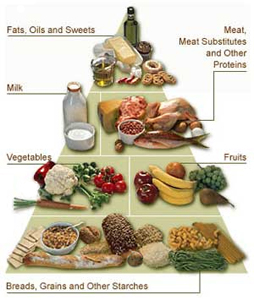
The Diabetes Food Pyramid is another meal planning option that some people use. It is less popular compared to both carbohydrate counting and the plate method for diabetes management.
The Diabetes Food Pyramid divides food into six groups. These groups or sections on the pyramid vary in size. The largest group – grains, beans, and starchy vegetables – is on the bottom. This means that you should eat more servings of grains, beans, and starchy vegetables than of any of the other foods. The smallest group – fats, sweets, and alcohol – is at the top of the pyramid. This tells you to eat very few servings from these food groups.
The Diabetes Pyramid gives a range of servings. If you follow the minimum number of servings in each group, you would eat about 1600 calories and if you eat at the upper end of the range, it would be about 2800 calories. Most women, would eat at the lower end of the range and many men would eat in the middle to high end of the range if they are very active. The exact number of servings you need depends on your diabetes goals, calorie and nutrition needs, your lifestyle, and the foods you like to eat. Divide the number of servings you should eat among the meals and snacks you eat each day.
The Diabetes Food Pyramid is a little different than the USDA Food Guide Pyramid because it groups foods based on their carbohydrate and protein content instead of their classification as a food. To have about the same carbohydrate content in each serving, the portion sizes are a little different too. For example: you will find potatoes and other starchy vegetables in the grains, beans and starchy vegetables group instead of the vegetables group. Cheese is in the meat group instead of the milk group. A serving of pasta or rice is 1/3 cup in the Diabetes Food Pyramid and ½ cup in the USDA pyramid. Fruit juice is ½ cup in the Diabetes Food Pyramid and ¾ cup in the USDA pyramid. This difference is to make the carbohydrate about the same in all the servings listed.
Following is a description of each group and the recommended range of servings of each group.
Health by Chocolate – How enjoying a little chocolate might actually help your health.
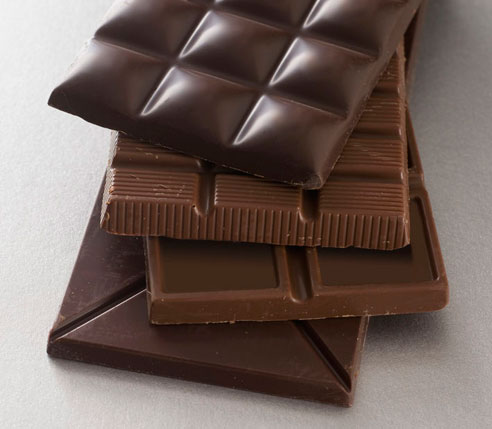 “Take two squares of dark chocolate and call me in the morning.” I’d be all over those doctor’s orders! Can eating chocolate really be good for your health?
“Take two squares of dark chocolate and call me in the morning.” I’d be all over those doctor’s orders! Can eating chocolate really be good for your health?
Well, if it is, I’m certainly in great shape. I rarely let a day go by in which I don’t enjoy a little bite of chocolate. I crave a little bit a day, much like those people who MUST have two cups of coffee in the morning.
The craving usually hits me mid-morning or right after lunch. A couple of squares or a small handful of chocolate-covered nuts, and I’m good to go. I just love the smoothness and the flavor of chocolate. No other food quite compares to it.
Chocolate and Your Health
The possible health benefits of chocolate stem from the antioxidant flavonoids. Chocolate comes from the cacao plant, and cacao is extraordinarily rich in flavanols, a type of flavonoid phytochemical. (Other plants rich in flavanols include tea, grapes, grapefruit, and wine.) That sounds simple enough, but some forms of chocolate have a lot more flavonoids than others.
So here’s Health by Chocolate Rule of Thumb #1: The more nonfat cocoa solids a chocolate product contains, the more antioxidants it tends to contribute.
And what about the fat found in the cacao bean? It’s true that cacao contains some saturated fat. But most of it is stearic acid — which studies have suggested doesn’t elevate blood cholesterol levels as much as other saturated fatty acids. The other fatty acids in cocoa butter are monounsaturated fat (considered a desirable fat) plus another saturated fat called palmitic fatty acid. But here’s where it gets confusing: chocolate products can have other types of fat added, like “milk fat” or “partially hydrogenated vegetable oil” or even coconut or palm oil (both naturally saturated oils), in addition to “cocoa butter.”
So here’s Health by Chocolate Rule of Thumb #2: If the chocolate contains fat ingredients other than cocoa butter, it might contain the more harmful saturated fats and trans fats, rather than stearic acid.
One tablespoon of cocoa butter oil contains:
- 8 grams of saturated fat (4.5 grams of which are from stearic acid and 3.5 grams of which are from another saturated fatty acid).
- 4.5 grams of monounsaturated fat.
- 0.4 grams of polyunsaturated fat (most of which is omega-6 fatty acids).
The Possible Health Benefits of Chocolate
More research needs to be done, but recent studies suggest four possible health benefits of dark chocolate and cocoa.
1. They May Reduce the Risk of Heart Attack.
A few squares of dark chocolate a day can reduce the risk of death from heart attack by almost 50% in some cases, says Diane Becker, MPH, ScD, a researcher with the John Hopkins University School of Medicine. Becker’s research found that blood platelets clotted more slowly in people who had eaten chocolate than in those who had not. This is significant because when platelets clump, a clot can form, and when the clot blocks a blood vessel, it can lead to a heart attack.
The Possible Health Benefits of Chocolate continued…
“The flavanols in cocoa beans have a biochemical effect of reducing platelet clumping, similar to but much less than aspirin,” Becker says in an email interview.
After reviewing 136 scientific publications on chocolate and its components and heart disease, researchers from Harvard University School of Public Health concluded that short-term studies suggest cocoa and chocolate may reduce the risk of cardiovascular disease by:
- Lowering blood pressure
- Decreasing LDL oxidation
- Anti-inflammation action
2. They May Decrease Blood Pressure and Increase Insulin Sensitivity
Researchers in Italy recently fed 15 healthy people either 3 ounces of dark chocolate or the same amount of white chocolate — which contains no flavanol phytochemicals — for 15 days. They found that insulin resistance (a risk factor for diabetes) was significantly lowered in those who ate the dark chocolate. Systolic blood pressure (the first number in a blood pressure reading), measured daily, was also lower in the group eating dark chocolate.
3. They May Improve Arterial Blood Flow
Healthy men who consume flavanol-rich cocoa may see improvements in the flow of blood through their arteries, according to recent research. The researchers found that when healthy men consumed the flavanol-rich cocoa, the ability of their blood vessels to relax improved significantly. And arterial blood flow is important for cardiovascular health.
4. They May Help People with Chronic Fatigue Syndrome
In a small study in England, 1 1/2 ounces of 85% cocoa dark chocolate was given to a group of adults with chronic fatigue syndrome every day for eight weeks. In the study, which has been submitted for publication, the participants reported feeling less fatigued after eating the chocolate. Surprisingly, no weight gain was reported in the chocolate-eating group, according to researcher Steve Atkin, PhD.
How might it work? The researchers believe that chocolate enhances the action of neurotransmitters, like serotonin, which help regulate mood and sleep. More research needs to be done to confirm a benefit in this area.
Not All Chocolate Is Created Equal
While the amount of the healthy antioxidant flavonoids varies from one type of chocolate to another, there’s one guideline you can take to the bank: The more nonfat cocoa solids in a chocolate product, the more antioxidants it likely contains.
So which type of chocolate has the most flavonoids? The highest levels are in natural cocoa powder (not Dutch cocoa, though, because it is alkalized cocoa). The type second highest in flavonoids is unsweetened baking chocolate. Dark chocolate and semisweet chocolate chips rank third, with milk chocolate and chocolate syrup at the bottom of the list.
Keep in mind, though, that flavanol levels in types of chocolate can vary based on:
- The cocoa beans selected.
- The processing of the beans and chocolate.
- Storage and handling conditions.
Perhaps in the near future, labels on chocolate products will list amounts of flavanols.
Which Type of Chocolate Has the Most Calories and Fat?
By far the lowest-calorie, lowest-fat form of chocolate is cocoa (the unsweetened type). A serving of 3 tablespoons has about:
- 60 calories
- 1.5 grams fat
- 0 grams saturated fat
- 3 grams fiber
The equivalent in unsweetened baking chocolate is 1 square (1 ounce), which contributes:
- 140 calories
- 14 grams fat
- 9 grams saturated fat
- 4 grams fiber
By comparison, a typical 2-ounce serving of semisweet or milk chocolate (with sweetener and other ingredients added) contains:
- 270 calories
- 17 grams of fat
- 10 grams of saturated fat
Semisweet chocolate adds around 3 grams of fiber per 2 ounces, while milk chocolate typically contributes zero. The mostly insoluble fiber in cocoa comes from the seed coat on the unprocessed cocoa bean.
All of this brings us to Health by Chocolate Rule of Thumb #3: For a better flavonoid-to-calorie ratio, choose cocoa powder whenever possible for baking and making hot chocolate.
Don’t Forget the Calories
One thing most chocolate bars have in common is calories. An ounce of sweetened chocolate will cost you about 150 calories — that’s about six to seven chocolate kisses. Here’s my take on it as a chocolate lover: Those six kisses are worth every calorie.
But here’s a word of caution: The health benefits of chocolate may disappear if you are adding the calories above and beyond your regular intake. This could mean you’re adding pounds along with the flavonoids.
Researchers from the University of California at Davis said it best in a scientific review on cocoa and chocolate flavonoids published in the Journal of the American Dietetic Association. They concluded that people may benefit from including a variety of flavonoid-rich foods as part of a healthful diet — and dark chocolate, in moderate amounts, can be part of this plan.
New and Improved Chocolate Products
Now that the word is out that chocolate may have health benefits, special chocolate products are hitting the shelves. Two examples are CocoaVia and Hershey’s Cacao Reserve.
1. CocoaVia (by Mars Inc.)
This product contains cocoa powder with a higher amount of flavanol than your average chocolate bar. The company has also added cholesterol-lowering soy sterol esters (similar to the type in Benecol and Take Control margarines). They have also added B-vitamins and calcium and two antioxidant vitamins, C and E.
Whether all this leads to much health benefits remains to be seen. I can tell you that the products I’ve tried taste worthy of your attention. If you are interested in trying CocoaVia, try to find them on sale because as the amount of nutrients and flavanols went up, so did the price.
There are several types of CocoaVia bars. The Original Chocolate Bars contain (per 22-gram serving):
- 100 calories
- 6 grams fat
- 3.5 grams saturated fat
- 9 grams sugars
2. Hershey’s Cacao Reserve
Want some of the benefits of dark chocolate but with the flavor of milk chocolate? Try the milk chocolate bars in the Cacao Reserve line by Hershey’s. I found them in my drugstore. I tried the Milk Chocolate with Hazelnuts with 35% Cacao. It was delicious, and a cross between a milk chocolate bar and a dark chocolate bar, I think.
Per 1 ounce (that’s a little more than 28 grams):
- 162 calories
- 11 grams fat
- 5 grams saturated fat
- 11.8 grams sugars
Chocolate Recipes
If you’re ready to cash in on the possible health benefits of chocolate (or at least the taste benefits), here are a couple of lighter dessert recipes to fulfill your chocolate cravings.
Chocolate Raspberry Pound Cake
WebMD Weight Loss Clinic members: Journal as 1 portion medium dessert
Dust this cake with powdered sugar and serve with fresh raspberries and a dollop of Light Cool Whip or whipping cream, if desired. If you don’t want to use Splenda, increase the sugar to 1 1/2 cups.
3/4 cup less-sugar raspberry preserves
1 cup whole-wheat flour
1 cup unbleached white flour
1 cup granulated sugar
1/2 cup Splenda
3/4 cup baking cocoa
1 1/2 teaspoons baking soda
1 teaspoon salt
1/2 cup less-fat margarine (with 8 grams of fat per tablespoon), preferably with plant sterols added
3 tablespoons raspberry-flavored liqueur (fat-free half-and-half can be substituted)
16 ounces fat-free sour cream
2 large eggs (use higher omega-3 type, if available)
1 1/2 teaspoons vanilla extract
Powdered sugar (for dusting)
- Preheat oven to 350 degrees. Coat an angel food pan (tube pan) with canola cooking spray and dust lightly with flour. Place the raspberry preserves in a small microwave-safe bowl and heat on HIGH for 15 seconds or until softened.
- Add whole-wheat and white flours, sugar, Splenda, cocoa, baking soda, and salt to large mixing bowl and beat on low to blend well. Stop mixer and add margarine, liqueur, sour cream, eggs, vanilla, and softened preserves all at once. Beat on medium speed for two minutes, scraping sides of mixing bowl after a minute.
- Pour batter into prepared pan and bake for 50-60 minutes, or until cake tester inserted in center comes out clean. Cool in pan 10 minutes, then remove cake from pan and place on serving plate to cool completely. When ready to serve, dust powdered sugar over the top. Serve with fresh raspberries and a dollop of whipped topping or whipping cream. if desired.
Yield: 16 servings
Per serving: 195 calories, 5 g protein, 36 g carbohydrate, 4 g fat, 1 g saturated fat, 3 g fiber, 311 mg sodium. Calories from fat: 18%.
Chocolate Truffle Bars
WebMD Weight Loss Clinic members: Journal as 1 portion of light dessert + 1 tablespoon nuts
If you would rather not use Splenda, simply delete it. These brownie-like bars have a wonderful texture, too.
2/3 cup less-fat margarine (with 8 grams of fat per tablespoon) like Take Control
1/3 cup fat-free half-and-half
7 ounces (7 squares) unsweetened baking chocolate, chopped
1 1/2 cups granulated sugar
1/2 cup Splenda
2 large eggs (use higher omega-3 type, if available)
1/2 cup egg substitute
1/2 cup whole-wheat flour
1/2 cup all-purpose white flour
1 1/2 teaspoon vanilla extract
1 cup walnut pieces
- Preheat oven to 350 degrees. Lightly coat a 9 x 13-inch pan (or two 9-inch square baking pans) with canola spray. Set aside.
- Add the margarine and fat-free half-and-half to a medium nonstick saucepan and melt the butter, stirring constantly, over medium-low heat. Once the margarine is melted, remove the pan from the heat.
- Add the chopped baking chocolate to the melted butter, stirring constantly with a wooden spoon until chocolate is completely melted. Add the sugar and Splenda and stir to blend well.
- Add the eggs, one at a time, stirring vigorously after each. Add egg substitute and stir to combine. Add the whole-wheat and white flours and stir to combine. Stir in the vanilla extract and walnuts.
- Pour batter into prepared baking pan(s) and bake for 23-25 minutes (20 minutes if using two pans). The brownies will still look somewhat soft and shiny. Remove from the oven and place on cooling rack.
Yield: 24 bars
Per serving: 130 calories, 3 g protein, 15 g carbohydrate, 7 g fat, 2 g saturated fat, 2.5 g monounsaturated fat, 2.5 g polyunsaturated fat, 13 mg cholesterol, 2 g fiber, 31 mg sodium. Calories from fat: 50%.